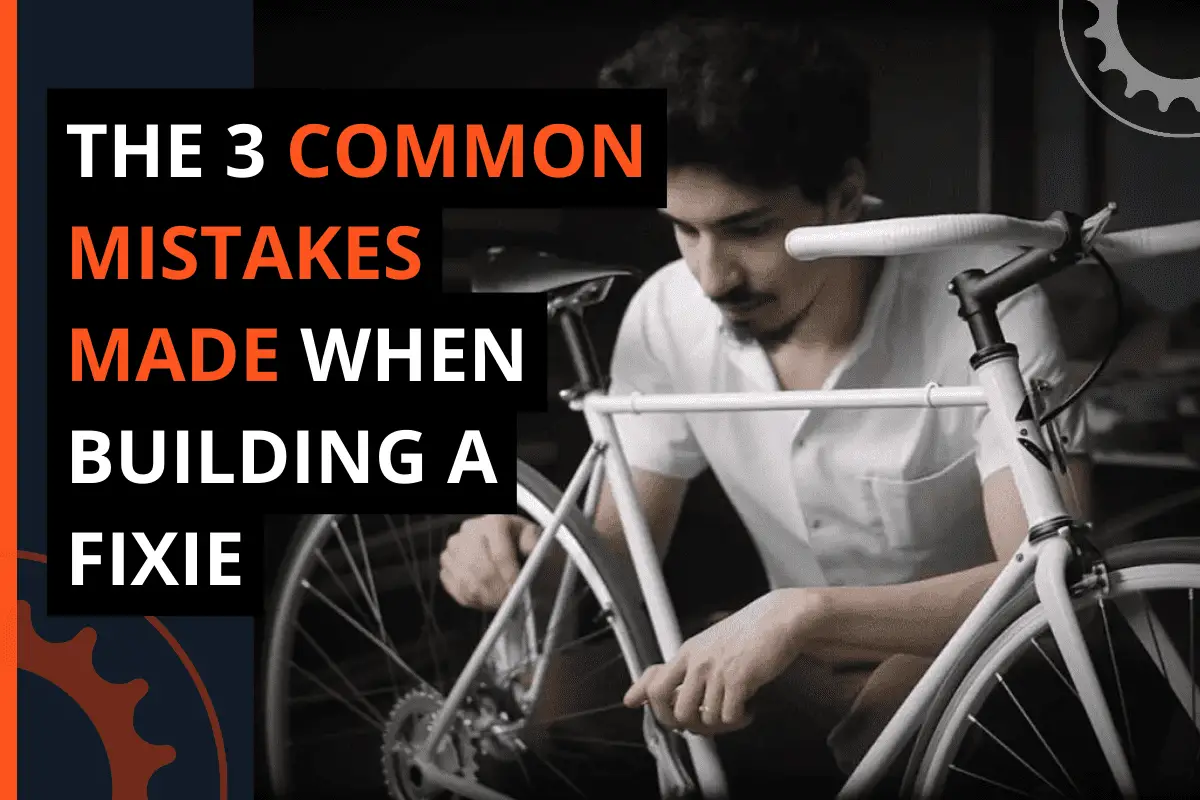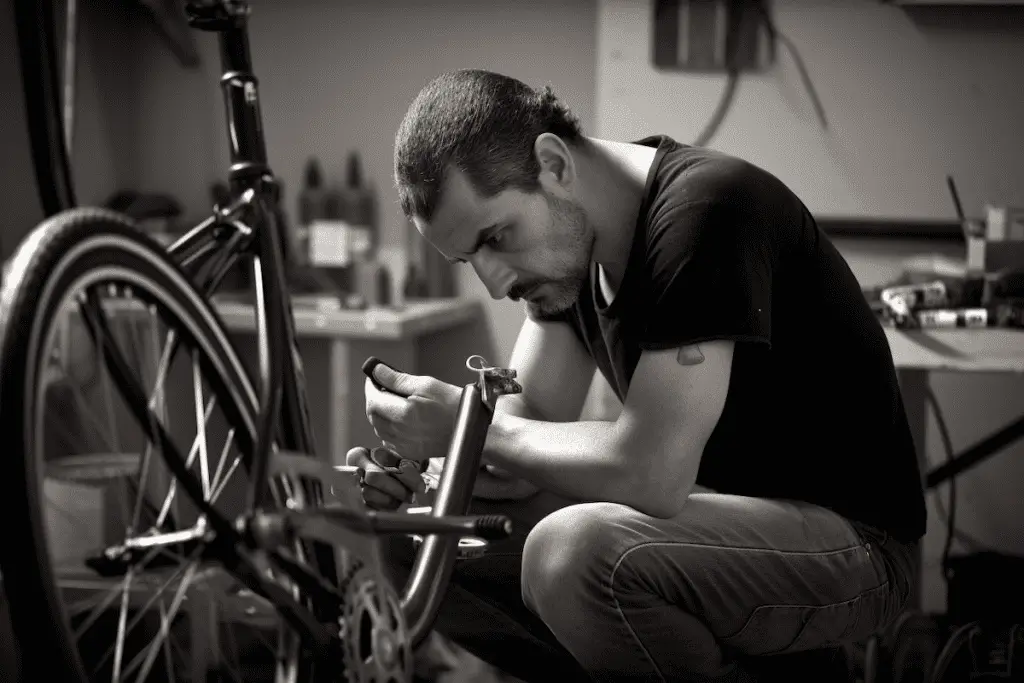As an avid fixed-gear cyclist, I recently embarked on a journey to build my first fixed-gear bike from scratch. It was a challenging yet rewarding experience that taught me a lot about the intricacies of these unique bicycles.
So, in this post, I want to share my knowledge with others, so today, I present to you the six most common mistakes made when building a new fixed-gear bike.
Three common mistakes to avoid when building a new bike
Now, let’s explore the six most common mistakes to avoid when building your fixed-gear bike:

1. Incorrect chain tension
Chain tension is crucial for the smooth functioning of a fixed-gear bike. An overly tight chain puts unnecessary stress on the drivetrain and can lead to premature wear, while a loose chain may cause the chain to slip off the chainring and sprocket.
To avoid this mistake, make sure to properly adjust the rear wheel in the dropouts to achieve the correct chain tension. There should be a slight amount of play in the chain, but not so much that it risks derailing. Investing in a chain tensioner can also help maintain consistent tension as you ride.
2. Improper component compatibility
Not all bike components are interchangeable, and using incompatible parts can lead to unsafe riding conditions or even damage to your bike. Key areas to pay attention to include the bottom bracket, headset, and wheelset.
When selecting components for your build, ensure that you choose parts that are compatible with your specific frame and fork. For example, the bottom bracket shell width and threading must match the specifications of your frame. Similarly, the headset must be designed to fit the head tube of your frame and the steering tube of your fork.
3. Misaligned brake setup (for those adding brakes)
While many fixed-gear bikes are ridden brakeless, some riders choose to add a front or rear brake for added stopping power. If you decide to add brakes to your build, it’s essential to ensure proper alignment and functionality.
…make sure the brake pads are parallel to the rim and correctly positioned to make full contact when applied.
A common mistake is setting up the brake pads unevenly or too far from the rim. This can result in reduced braking power, uneven wear on the brake pads, and even damage to the rim. To avoid this issue, make sure the brake pads are parallel to the rim and correctly positioned to make full contact when applied.
4. Neglecting proper saddle and handlebar positioning
Your bike’s saddle and handlebar positioning plays a crucial role in your comfort and overall riding experience. A common mistake is not paying enough attention to the height, angle, and fore-aft position of the saddle and handlebars.
To find your ideal saddle height, sit on your bike and place your heel on the pedal at its lowest point. Your leg should be fully extended but without overextending your knee. Adjust the angle of your saddle to be parallel to the ground and fine-tune the fore-aft position to maintain proper knee alignment over the pedal spindle.
When it comes to handlebars, the height and reach should allow you to comfortably grip the bars without straining your back, neck, or shoulders. Experiment with different stem lengths and angles to achieve your desired riding position.
5. Failing to properly grease components
Lubricating your bike’s components is essential for smooth operation and to prevent issues like seizing or corrosion. A common mistake is either not using enough grease or using the wrong type of grease on parts like the bottom bracket, headset, Seatpost, and pedal threads.
Ensure that you apply a liberal amount of high-quality bicycle grease to threaded components and metal-to-metal contact points. This will not only protect your bike from the elements but also make future disassembly and maintenance much easier.
6. Overlooking regular maintenance and inspection
Once your fixed-gear bike is built, it’s essential to regularly maintain and inspect it to keep it in top condition. Neglecting maintenance can lead to unexpected breakdowns or accidents.
Develop a routine for checking your bike before each ride, including inspecting the frame and fork for cracks or damage, examining the chain for wear, verifying the tires for proper inflation, and confirming that all nuts and bolts are tight. Schedule periodic maintenance for cleaning and lubricating your chain, adjusting your brake (if you have one), and servicing your bottom bracket and headset.

State Bicycle Co. Black Label 6061

State Bicycle Co. Black Label 6061
Upgrading your fixed-gear bike for enhanced performance
As you gain experience riding your fixed-gear bike, you may start considering upgrades to enhance its performance and suit your specific needs. Popular upgrades include lighter wheelsets for improved acceleration and reduced overall weight, sturdier tires for puncture resistance and better grip, and ergonomic handlebars or grips for increased comfort on long rides.
Additionally, investing in a high-quality chain and cog can improve the longevity and smoothness of your drivetrain. Remember to research and choose components that are compatible with your bike and riding style for the best results.
Dont forget to embrace the fixed-gear community and culture
One of the most rewarding aspects of becoming a fixed-gear cyclist is joining the vibrant and passionate community that surrounds these unique bikes. Participate in local group rides, alley-cat races, or other fixie events to connect with fellow riders and learn from their experiences.
Engaging in online forums or social media groups can also be a valuable resource for advice, troubleshooting, and inspiration. Embracing the fixed gear community and culture will not only deepen your appreciation for these bicycles but also provide you with a supportive network of like-minded individuals who share your passion.
Want more context? Watch this video on how to build a fixed-gear bike.
Frequently asked questions (FAQ)
Do you still have questions about building bikes? Below are some of the most commonly asked questions.
How do I correctly set my chain tension?
Adjust the rear wheel in the dropouts and ensure a slight chain play without risking derailment.
How do I find my ideal saddle height?
Sit on the bike, place your heel on the pedal at its lowest point, and adjust the height for a fully extended leg without overextending your knee.
How often should I maintain my fixed-gear bike?
Inspect your bike before each ride and schedule periodic maintenance for cleaning, lubricating, and servicing key components.
Conclusion
Building and maintaining a fixed-gear bike is a rewarding process that requires attention to detail and ongoing care. By avoiding these common mistakes, you’ll be well on your way to enjoying countless miles of smooth, efficient, and enjoyable rides on your custom fixie. Remember, knowledge is power – the more you learn, the better your bike will be. Happy riding!
If you found this article helpful, share it with a friend, and check out my full blog for more tips and tricks on bike buying and maintenance. Thanks for reading. Happy riding, and pedal on.
Key takeaways
This article covered mistakes made when building a bike. Here are some key takeaways:
- Avoid common mistakes when building a fixed-gear bike, such as incorrect chain tension, improper component compatibility, and misaligned brake setup, to ensure a safe and enjoyable riding experience.
- Prioritize proper saddle and handlebar positioning for optimal comfort and efficient riding, and remember to grease components regularly to protect against corrosion and facilitate smooth operation.
- Establish a routine for regular bike maintenance and inspection to prevent unexpected breakdowns or accidents and keep your fixed-gear bike in top condition.
- Utilize helpful resources, such as comprehensive guides, expert tips and tricks, and video tutorials, to expand your knowledge and perfect your fixed-gear bike assembly and maintenance skills.
Helpful resource
- The Comprehensive Guide to Building Your Own Fixed Gear Bike Sheldon Brown’s website is a treasure trove of information on bicycle mechanics, with a dedicated section for fixed gear bikes. This comprehensive guide covers everything from choosing the right components to assembling and fine-tuning your fixie.
- Fixed Gear 101: Essential Tips and Tricks for New Riders Park Tool is a reputable name in the bicycle repair industry, and their blog offers numerous repair help articles. The “Fixed Gear 101” article provides valuable insights, tips, and tricks for new fixed gear riders, including guidance on how to ride, and maintain your fixie.
- How to Properly Adjust Your Fixed Gear Bike’s Chain Tension This YouTube video tutorial by Global Cycling Network demonstrates how to correctly adjust the chain tension on your fixed gear bike. The step-by-step instructions will help ensure your chain has the right tension for optimal performance and longevity.















